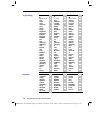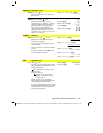
Appendix A: Functions and Instructions 417
8992APPA.DOC TI-89 / TI-92 Plus: Appendix A (US English) Susan Gullord Revised: 02/23/01 1:48 PM Printed: 02/23/01 2:21 PM Page 417 of 132
augment()
MATH/Matrix menu
augment(
list1,
list2
)
⇒
list
Returns a new list that is
list2
appended to
the end of
list1
.
augment({1,
ë
3,2},{5,4})
¸
{1
ë
3 2 5 4
}
augment(
matrix1
,
matrix2
)
⇒
matrix
augment(
matrix1
;
matrix2
)
⇒
matrix
Returns a new matrix that is
matrix2
appended to
matrix1
. When the “,” character
is used, the matrices must have equal row
dimensions, and
matrix2
is appended to
matrix1
as new columns. When the “;”
character is used, the matrices must have
equal column dimensions, and
matrix2
is
appended to
matrix1
as new rows. Does not
alter
matrix1
or
matrix2
.
[1,2;3,4]
!
M1
¸
[
1 2
3 4
]
[5;6]
!
M2
¸
[
5
6
]
augment(M1,M2)
¸
[
1 2 5
3 4 6
]
[5,6]
!
M2
¸
[
5 6
]
augment(M1;M2)
¸
1 2
3 4
5 6
avgRC()
CATALOG
avgRC(
expression1
,
var
[
,
h
]
)
⇒
expression
Returns the forward-difference quotient
(average rate of change).
expression1
can be a user-defined function
name (see
Func
).
h
is the step value. If
h
is omitted, it defaults
to 0.001.
Note that the similar function
nDeriv()
uses
the central-difference quotient.
avgRC(f(x),x,h)
¸
f(x+h) - f(x)
h
avgRC(sin(x),x,h)|x=2
¸
sin(h+2) - sin(2)
h
avgRC(x^2
ì
x+2,x)
¸
2.
ø
(x
-
.4995)
avgRC(x^2
ì
x+2,x,.1)
¸
2.
ø
(x
-
.45)
avgRC(x^2
ì
x+2,x,3)
¸
2
ø
(x+1)
4
Bin
MATH/Base menu
integer1
4
Bin
⇒
integer
Converts
integer1
to a binary number. Binary
or hexadecimal numbers always have a 0b or
0h prefix, respectively.
256
4Bin
¸
0b100000000
0h1F
4Bin
¸
0b11111
0b
binaryNumber
0h
hexadecimalNumber
Without a prefix,
integer1
is treated as
decimal (base 10). The result is displayed in
binary, regardless of the
Base
mode.
If you enter a decimal integer that is too large
for a signed, 32-bit binary form, a symmetric
modulo operation is used to bring the value
into the appropriate range.
A binary number can have up to
32 digits. A hexadecimal number
can have up to 8.
Zero, not the letter O, followed by b or h.


















